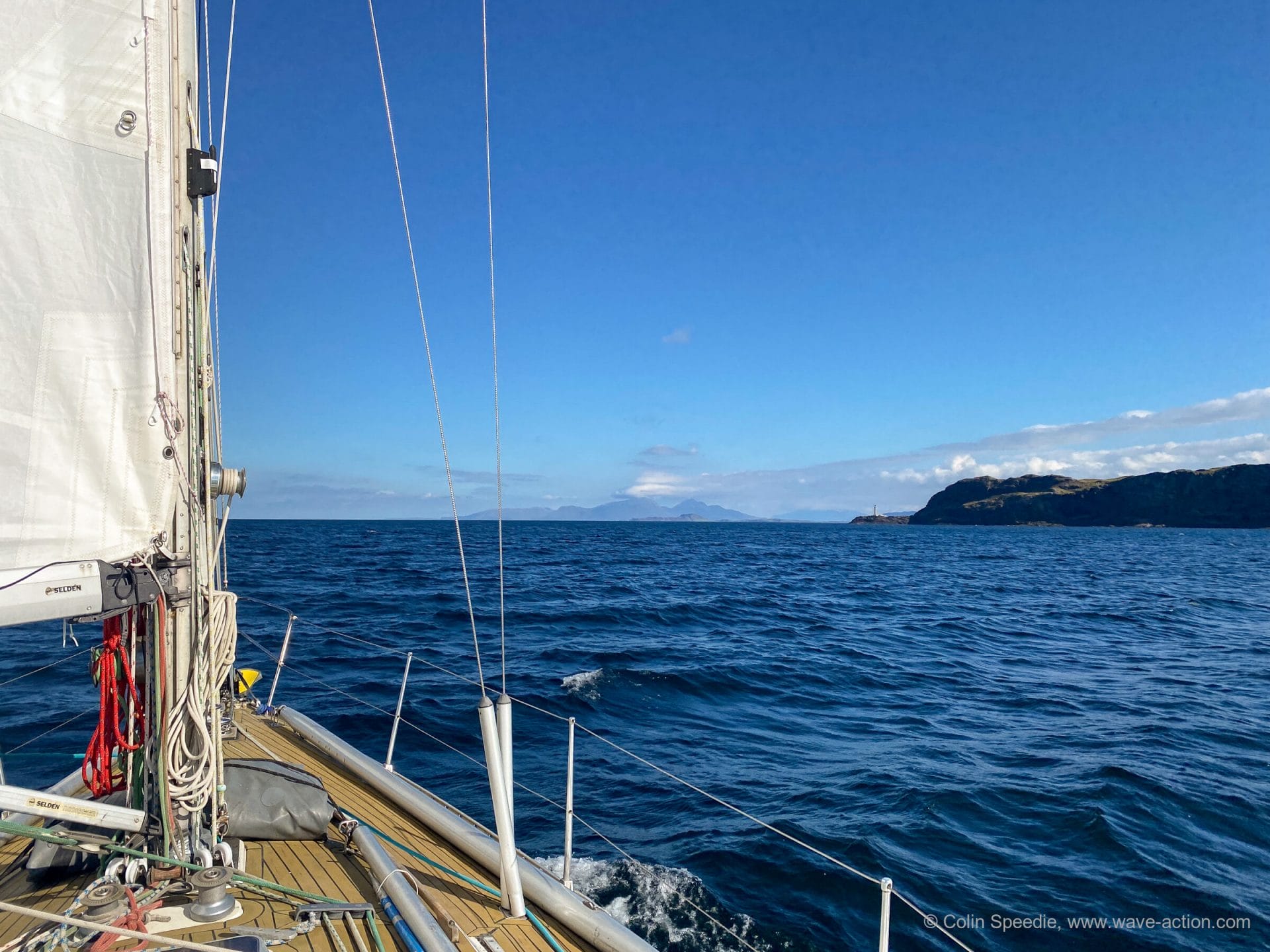
We rejoin Colin and his new-to-him but fast becoming well-loved She 36 Sherpa for the last leg of their long delivery passage home to Scotland, and conclude with how much money and time he and Louise have in the boat, as well as future expenditures and time budgets.
After a forced two-week pit stop caused when our ancient and worn Gori folding propeller shed a blade, our new Featherstream feathering prop arrived.
New Prop
These are beautifully engineered propellers. We had one on our Ovni 435 for ten years that never needed any servicing apart from annual cleaning and greasing, so it was a no-brainer to order one for Sherpa.
Darglow Engineering is one of those firms that really try hard, and bless them, they pulled out all the stops to get us back in action. Excellent value for money, beautifully packed, with everything in the box—spare grease, thread lock, etc, that’s required to fit the new prop.
I was off the very next day to fit it in Largs, 100 miles away.
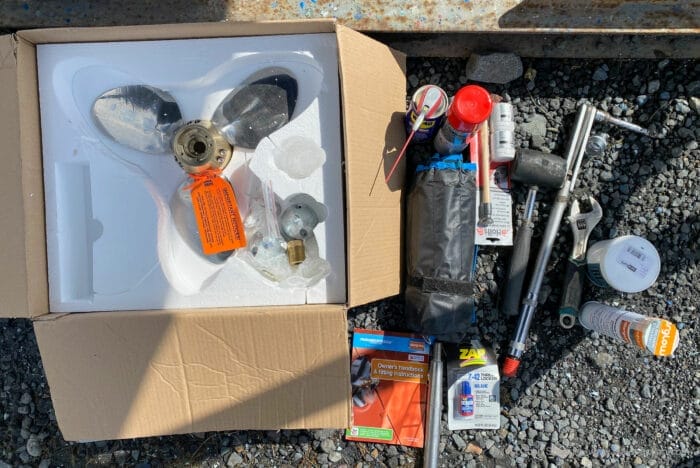
On a soggy Sunday afternoon, it took only a few hours before I was happy with the installation. The following morning, she was back in the water, fuel and water tanks topped off, and lockers crammed with food—we were ready to roll.
The prop was as smooth as silk, pitch spot on and, hallelujah, loads of grip astern—perfect. Thank you, Darglow!
Ronnie Returns
Lou was away on a long-planned conservation holiday, so I turned to our trusty crew member Ronnie Mackie. Ronnie has sailed extensively with us, including our trans-Atlantic crossing from Cape Verde to Brazil (as well as many other adventures), and is our ‘go-to’ guy for such passages.
The best crew are the ones you know, trust and are compatible with. If they are also first-class sailors, tireless and endlessly upbeat like Ronnie, they are pure gold.

Knowing that this passage (spring tides, Mull of Kintyre, Ardnamurchan Point, etc.) was not for the faint-hearted, especially a ‘pedal to the metal’ run between weather systems, he was the ideal companion.
Departing Largs on a Monday lunchtime, we knew we had only until Thursday evening to reach home before the next vigorous frontal system whacked into the west coast of Scotland.
In terms of mileage alone this should be straightforward, but with spring tides to face, at times it would be a challenge. But there it was, we were determined to make it, and we had the boat to do it.

Light winds on the first day took us around the north end of Arran, then down through Kilbrannan Sound to Campbelltown, arriving after dark and going alongside at the small marina.
A quick supper, then off to bed with the alarm set for 04:20, as I knew (from previous experience) the run down to the Mull of Kintyre is slow going against a foul tide so vital to start early if you’re to arrive at the right time to pick up the ebb tide north off the Mull.
A fresh northerly wind hustled us south and we sped around the inshore route in fine style, which was when I started to think we were going to be very early at the Mull. Suspiciously early, in fact.
Oops
I had misread the tide tables. We could kill time by heaving-to or go inshore and drop our hook for a few hours.
Or we could go on and take a peek at the conditions off the Mull and see whether it was doable. The logic behind this being that, with the now stiff northerly funnelling through the North Channel, once the spring tide turned in our favour the overfalls inshore would be pretty hideous, but for now, with wind and tide together, the worst that could happen would be that we would slowly skirt the worst area of the race and claw slowly north in ‘relatively’ smooth conditions.
Fortune favours the brave, apparently, so off we went.
Which turned out to be absolutely the right thing to do. We rounded the Mull a couple of miles offshore; the sea wasn’t at all bad and we were able to march upwind as far as the inconveniently sited Traffic Separation Scheme before tacking back to stay out of it.
Best of all, the wind kept steadily shifting in our favour, and now into the last two hours of the foul tide, we were moving along very well, indeed.
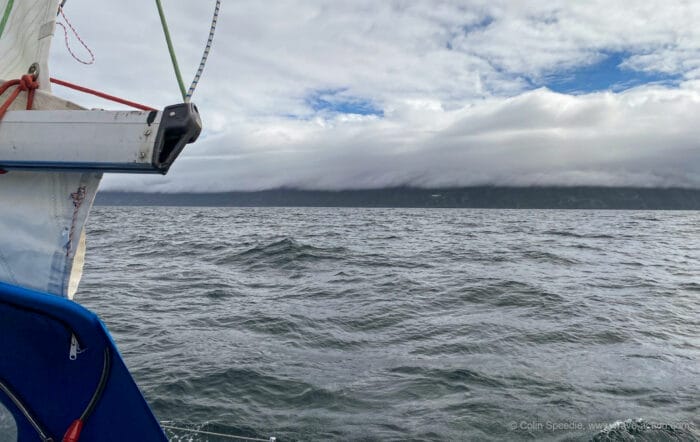
It was a model rounding, with the tide eventually turning in our favour as we beat north in fine style, exceeding our wildest expectations of the day’s run before we gave in to the new foul tide halfway up the Sound of Jura and found perfect shelter from the northerly wind in Loch Na Cille, where we came to anchor for the night.
Just the best day’s sailing, if wearing, and we slept like logs.
Up and away on a cloudy morning with the Sound of Jura like a millpond. So we kept as close in on the western shore as we dared to cheat the foul tide.
Slow going it was, but every mile gained would be a plus further on, when we could expect to have up to nine hours of tide in our favour.
The tide turned at last in the tidal bottleneck in the north end of the Sound of Luing and we raced through at ten knots.
Still, no wind for the rest of the day, so we motored the length of the Sound of Mull with the tide under us all the way, gaining many valuable free miles. We celebrated with an early night at Tobermory.
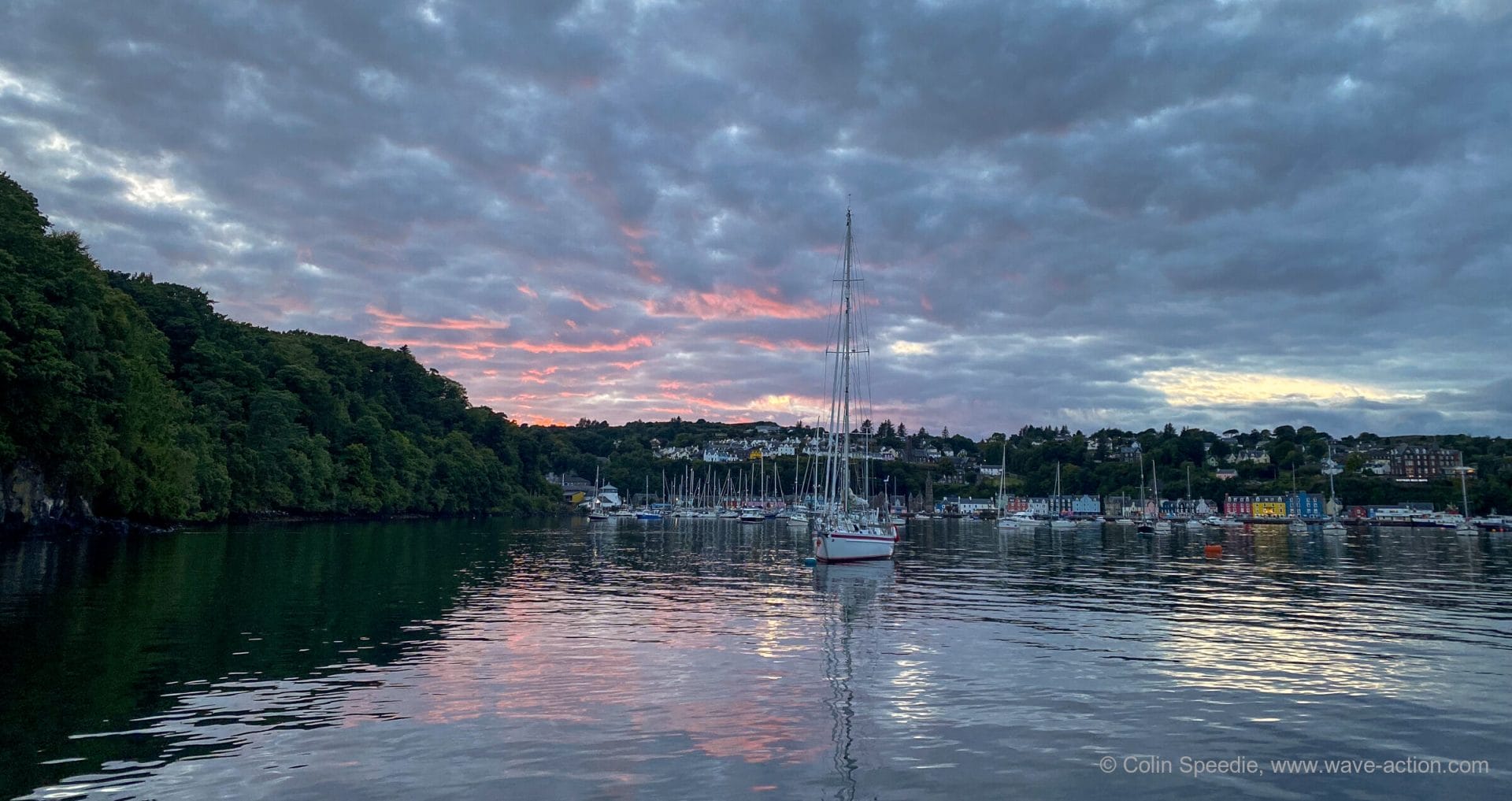
The first signs of the forthcoming change in the weather were in the morning sky, but the worst looked to be arriving overnight when we should be safely tucked up somewhere.
As so often this year, the weather was coming from the east, which should mean less sea running but possibly strong katabatic squalls in the mountainous region we live in.

To make sure we were well ahead of the change, we were up and away early and rounded Ardnamurchan Point in a strong southeasterly, and flew across towards Arisaig, the breeze strengthening all the way and (once again) we arrived far earlier than we had anticipated.
We spent a happy couple of hours tacking and gybing around, watching a variety of whales and dolphins, a common scene in this wild and beautiful area.
Two hours after low water we crept over the shallow patch into Arisaig. What a passage. A good meal and then off to bed early, only to be woken during the night by the first of the squalls off the hills. It was good to be so close to home.
The Final Leg
Two weeks later, Lou returned, and we boarded Sherpa on a cool morning to sail her around the last few miles to our newly laid mooring in Loch Ailort.
Summer seemed a distant memory as yet another strong northerly hustled us around the coast and Sherpa finally entered her new home, winding through the rocks and islets before coming to rest under the looming presence of Roshven, high above her. Home at last!
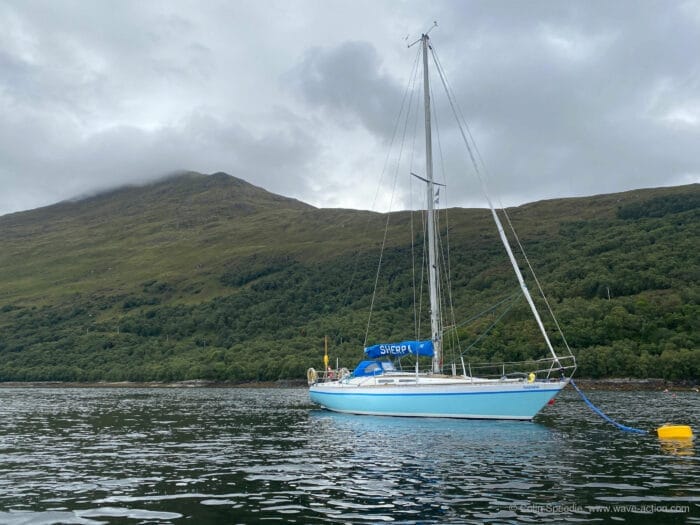

and you can do it for even less.
by the way, how many orders do you have on the A40?
Hi Pedro,
We have not yet started taking orders for the A40.
im sure 2024 will be the year that happens.
any more updates comming up?
Hi Pedro,
Just working on an update article. Look for it before the holidays.
Thank you Colin for the great read. Happy to hear that you are as happy with your new steed as we are with ours 😉
And we’re happy she’s gone to such a good home and is being used as she should be!
Having just installed a Darglow/Featherstream propeller, I couldn’t agree more with Colin’s positive comments about them.
We had one on our old boat and it never gave a moments trouble over 10 years. Looks like the new one will do the same. Glad you’re happy with yours.
Likewise from me. I was at Darglows last week dropping off a Maxprop for a rebuild. Nice people. I was reminded what beautiful, almost sculptural, objects the Featherstreams are. If something looks good it often is. Made me wish I could replace the Maxprop with one. I installed a three bladed one on a Twister 28 a few years ago. Excellent product although it did not tame the Twister’s wilful behaviour when going astern. Enjoyed the article.
I, too, love fine engineering, truly kinetic art. Almost too good to use….
Wilful behaviour explains the muleish tendencies of those long keelers perfectly Port or starboard? Might as well toss a coin.
Glad you enjoyed the article – thanks.
Colin
Man, I just love reading your articles. Makes me feel good!
(Yours are good too, John)
Can’t wait for more updates. Specifically the jibstay.
Thanks
Ralph
That’s very kind of you to say so – thank you. I’ll keep them coming!
Best wishes
Colin
Very good article, appreciate very much of the perspective on boat capabilities to be an offshore cruiser. I’ve an Alpa 11.50 that, altough was not designed by the renowed S&S, shares similar dimensions. I was always thinking of buying a biggest one, maybe influended by the current fashion – at least in the Med – that if don’t have a 45+ your a second order sailor – but after reading your comments about its capabilities I.m thinking of keeping it, maybe renovating some old stuff, but not changing it. What I like of mine is that’s the right size to be managed (and owned I’d say) solo, whitout much anxiety, while going longer and heavier I doubt it could be that easy.
Hi Michele
The Alpa looks very similar to Sherpa, with maybe a bit more room?
To me, the question of size is a very personal one. Having worked on boats for many years, I definitely didn’t want anything too big or too complex, hence our choice for the two of us to liveabord was around 45ft. Affordable, comfortable and safe at sea, if I had the choice tomorrow, I’d choose an almost identical size.
Now that we’re more housebound, 36 feet (for a couple, again) is about perfect in my view. We can afford it (just) it’s less physical and infinitely more manageable. What’s not to like?
A 36 will go anywhere our 45 ft would, a little slower of course and less ‘luxury’ (which is indefinable) but it’s the being there that counts! If you like her as much as you say, and have no ‘need’ of a bigger boat, well then, love the one you’re with!
Best wishes
Colin
Hi Colin,
You got a great start on your $100k budget by buying Sherpa for $40K. I’m assuming we’re talking USD here so, in my Canadian context, that’s $135K. But I’m sure you got that price by fully researching the boat and knowing what you were laying out for it.
I was in a similar situation 3 years ago when my wife and I started to look for an ocean-going upgrade to our 30-footer. After 6 months of looking on-line and visiting boats that were generally in much better condition online than in reality, we spent 3 days visiting Quebec City and looking carefully at a custom steel “Caroff 36” swing keel, solent-rigged sailboat.
Colin, you would feel at home on her, having owned an OVNI, as Gilbert Caroff was among the first French designers to propose and design swing keel metal boats. Unlike OVNIS which are factory mass produced, Caroff offered his designs as drawing packages for sale. My Caroff was, fortunately, commissioned through a small but professional shipyard near Quebec City. So it does not suffer from the construction flaws and shortcuts that are typical of many “kit boats”.
The owner was very gracious and let us empty the boat to inspect her thoroughly (as long as we returned everything in its place) and even let us sleep in her for two nights before our purchase decision was made. This really allowed us to get a feel for the vessel. I noted a number of deficiencies and made a counter-offer on her, finally settling on $CDN 66K, which is not that far off the $US 40K you spent on Sherpa. So, to those out there trying to replicate Colin’s feat, I can say that it wasn’t a unique price/value offering. They are out there!
Since the purchase, we’ve spent the time between bouts of refit work to get to know the boat through day-sails and short passages. To date I’ve:
While I haven’t been precisely adding up the bills, I estimate that I’ve spent about $CDN 20k, with probably another $CDN 30k to go before I feel secure to venture offshore. Maybe add another $CDN 10K if I have to replace the venerable Perkins 4-108 that is original to the vessel. While it has 6000 running hours, it’s been completely rebuilt a decade ago, starts every time and shows no signs of failure. In either case we should still be below the $US100k by the time we take her out on the ocean.
I’m heartened by the fact that this boat has performed four transatlantic passages under two previous owners and spent many years cruising the Med and Caribbean. Putting modesty aside for a moment, the changes we’ve made have resulted in a better boat, now, than she ever was.
Here’s some lessons we learned along the way:
Good luck with the rest of your refit and eventual passage-making. Maybe we’ll see you out there someday.
Rob and Caroline, onboard Mayero II
Hi Rob and Caroline
congratulations on taking on such a task. I don’t doubt you wouldn’t have done so without the knowledge you clearly possess, which is probably the case for us with Sherpa. As I explained early on in this series, there were a number of things that would need addressing and we would be bound to find more. But the basic boat was sound, and factored that in.
It’s a world of difference if you don’t have the skills. Labour rates today are punitive and it wouldn’t be cost effective – sad but true.
But, as you say, if you have the skills, you know your boat from stem to stern and there’s a lot to be said for that.
And good luck to you, too – you’ve earned it.
Colin
Hi Rob and Caroline,
Great comment and very interesting. Clearly you have the skills and background to take on this older steel boat.
That said, I do need to point out for others that you are already into substantial structural repairs, as is common with steel boats, that would be difficult and cost prohibitive for most other people.
Bottom line, buying an old steel boat is not a way to get out there that we recommend for most people: https://www.morganscloud.com/2024/10/06/hull-materials-which-is-best/
Having bought a Rival 41C from 1974 in 2010, and added up the refit costs (2015-18 plus in commission upgrades), I am firmly in the camp that buying a newer yacht would have been cost effective and likely less cost overall in real terms. I also would have been using the newer boat for longer.
Thinking of today’s changes to costs due to inflation, I am even more convinced that buying newer is better.
I now just turn up, cast off and sail, all the hard work is behind me, just running costs and some upgrade costs associated with my wants.
My advise to anyone buying an old boat, is to put it on hold, save hard, buy newer. You will sail more for less money.
Good common sense advice, Alastair, but where is the the newer version of the Rival 41 – a fine boat, the aft cockpit version of which my mother and stepfather crisscrossed the Atlantic in? I own its direct descendant, the Bowman 40, but that is over 30 ears old and after that the deluge. Very few sensible fibre glass cruising boats. Hence the opening for the Adventure 40.
I bought a boat in pretty good condition but even so stuff ages and breaks all the time. Rigging is supposed to be replaced every 10 years. Electronics become outdated as useful technological advances occurr. If you sail serious miles sails degrade equally seriously. Gear wears out. Even brand new boats seem to need a degree of fettling.
If you have the skills and the time and the inclination its true you can save a lot of money. I have neither the skills or the inclination and in my seventieth year I certainly don’t have the time. Admittedly that was also my attitude in my twenties. I just want to go sailing. It’s certainly satisfying when you can mend something yourself without calling in the professionals. I know John rails against hamfisted boatyard professionals but good ones do exist. I would rather take the pain of paying exorbitantly for their skills and experience, which far outweigh my own, rather than doing work myself, the efficacy of which I wouldn’t trust and which I view as drudgery. To paraphrase you I want to just turn up and go sailing.
I think Colin (and John too) have chosen great designs in a sweet size spot. If you go over 34-36 feet boats become a seriously expensive hobby.
Hi Mark,
Good point, the flip side of the argument is that there have been so few good offshore boats built in the last 10 years. As you point out, this is exactly why I came up with the A40 idea in the first place.
Hi Alastair,
My experience has been much the same. Even in the case of my 2004 J/109, if I could have found a newer boat (very little available when I bought the 109) I would have bought her. I think about 10 years old is generally the sweet spot.
By far the best boat I have ever owned was the M&R 56 and she was 5 years old when I bought her, and I went cruising to Newfoundland within a week of putting her in the water.
I looked on Yachtworld for 10 year old 39-41 footers and lo, one interesting one popped up. RM1260, nice nick and well specified. Unfortunately its the twin rudder version… I saw one ashore in Sicily recently with a chewed up starboard rudder. The twin keel single strong rudder looks much more the thing to me.
Hi Mark,
I agree on the vulnerability of twin rudders. That said, it would seem to me that on a twin keel boat, a single rudder would be vulnerable to debris pass between the two keels, although probably not as bad.
This was my conclusion as well. Of course, I consider a 20 year old boat “new” so long as the construction is superior and it’s been maintained well.
What I tell people about capable (ocean ready, long range cruising) older cruising boats in the 36-40 ft range is that it will cost you $100K minimum, whether that expense is borne in purchase price or some combination of purchase and refit, but it assumes doing your own work for nearly everything. I draw the line at standing rigging and major engine work. I’ve done spot deck recoring but more substantial areas probably should be done indoors and that usually means hiring professionals at very high rates (where I’m located they are over $120/hr). FWIW, the really difficult and expensive work is electrical and electronics because of the high equipment and material cost as well as the difficulty of planning and installation. Cramming yourself into small spaces for long periods or dealing with fidgety wiring is difficult on boats this size. It’s not for everyone.
I think we’re on the same page, then. And to do so the basic boat must be sound. Finding one that was worth the effort took two years.
I agree with your comment about electrical systems and electronics – I’m getting a bit old for that. And that’s before you start factoring in the removal of a huge amount of redundant wiring!
It has worked out for us (so far) only because I can do most of the work. Like you, I avoid rig and major engine work but nearly everything else will fetch up on my workbench.
But it’s worth it to us – see you on the water.
Hi Jesse,
I agree that even $100K is not an easy target to get under. That said, which tasks are beyond DIY depends a lot on the owner. For example, I find rewiring quite easy and even fun. And I have also replaced an engine myself without too much difficulty, although I would not try a rebuild. I have also done complex composite work with success, although I truly hate it so these days I delegate it. Also the pros are way neater and better than I am at glass work, but I’m way better than most of them at electrical and electronic and my engine installations are better thought out and executed than most yards can manage, even those specializing in re-power.
Point being that when thinking about taking on a refit, and budgeting it, our skills and proclivities are the most important variable.
More here on just that: https://www.morganscloud.com/category/refits/budgeting-a-refit/
We have a Wauquiez Pretorien 35 that fits this criteria and budget.
If we didn’t do almost all the work ourselves then it would have cost us more.
Ref: “Finally, electronics. When I said basic, I meant it. Lou hates fog (but then, who likes it?) and I am a huge fan of radar for navigation, safety, poor vis, etc.
But with most boats equipped with AIS these days, and more money and installation time to fit a radar, we decided to go with AIS as our main defense against collision in poor visibility, which we used extensively, especially in the busy waters of the English Channel, but never had such poor visibility that we would have needed a radar—luckily.”
Our experience with AIS is different. I’d guess maybe only 1% or less of boats in our general vicinity (Chesapeake Bay and U.S. east coast) have AIS installed… so for us, it’s more usual to NOT see AIS returns that would be useful for collision avoidance. We like having it it, of course, but don’t find it a useful alternative to radar in fog.
During our recent fog event — I could see the bow, but nothing much beyond another few feet or so — AIS was very useful. This was fog that reared it’s head after we were along about 70% of the day’s predicted plan, so not something we could have avoided by just staying in the previous port.
Eventually, there were three of us, later four, in a line following a narrow channel. As it happened, we all DID have AIS, as I said, unusual in our area. Our charts and plotters actually showed our own boat more or less correctly within the channel (a plus)… and we used AIS to be aware of each other… and by radio agreement on speed, to not inadvertently run up over each other.
BUT… we had to use both radar and crew watch on deck to “see” and avoid channel markers, and to confirm shorelines on both sides (and our distance from them). And when we arrived at our destination marina, several hours late, we couldn’t see the docks, had to be talked in — aided by dockhands with flashlights — to tie up. There were several boats already there with AIS, but many more without… Had we not had radar too, it would have been even more difficult to get ourselves in position to understand dock instructions.
I realize budgets are budgets, but I’d recommend having both radar and AIS if at all possible, and in this area, radar first if only one of the two is attainable.
FWIW. -Chris
Hi Chris,
Both Colin and I recommend radar, as well as AIS, for any area with fog: in fact we wrote bunch of chapters in our online book on just that together some years ago: https://www.morganscloud.com/category/navigation/book-navigation-electronics/
But sometimes when trying to actually get out there in a new-to-us boats, as Colin was, compromises must be made, so I think that was more what he was referring to in this case, rather than suggesting that AIS was adequate. This is also area dependant. In my experience of cruising UK waters, while mist is common, really thick fog is not.
Hi Chris,
My experience is that there are lots of boats I would not want to hit that do not have transponding AIS. And there are still many who have receive-only AIS and there are many in the small recreational fishing/runabout category that do not have AIS at all. I do not think vigilance in the form of slower speed, two sets of eyes looking, perhaps someone on the foredeck, and definitely someone on the helm to enable quick steering and access to the throttle and gears, and, finally, having ears in the open (no enclosure) can ever be softened with just using AIS.
And, I can still remember the days, pre our having radar, where we got caught out in fog and how exhausting those hours were. Running with radar can still be a challenge, but I believe is far safer for long periods and allows the boat to move at faster speeds.
My best, Dick Stevenson, s/v Alchemy
Hi Dick et al.
In an ideal world we would have had both – no question. As John suggests, other factors were at play, money and time (to install the radar) being the principal offenders.
Two things about our waters – one, fog is pretty rare. In the whole voyage we were fogbound for a morning. If fog is likely, the forecasts tend to show it, so with luck and good judgment we can work around it. Two, this is a busy area and I reckon that AIS is fitted to many more boats now as a result of prices going down (relatively) and sensible precaution-taking.
If we decide to push north into colder, foggier waters we may well change our mind on fitting radar. But, we have quite a lot to put right yet before we can justify that expense.
As John and I have said before – push comes to shove, radar takes an awful to of beating as a safety, navigation and security tool. If I could have no other installation, I’d go for radar every time.
None of this is intended to disagree with Dick’s points. Just some thoughts to explain our situation.
Best wishes
Colin
Hi Colin,
Understood and agree.
My comments were entirely directed at the idea that AIS could substitute for radar. And, to mention, my memory of the amount of work that running safely in fog with no radar entails.
My best, Dick